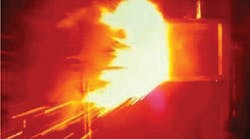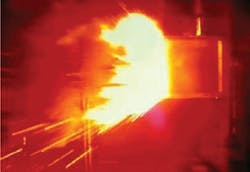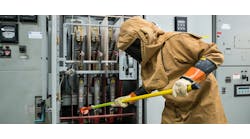As a plant manager you have a tough job — balancing workforce productivity, determining cost of materials, staying on top of union rules (when applicable), and running the plant at a profit. On top of all of this, you’re also responsible for compliance with OSHA regulations (see SIDEBAR: Arc Flash Rules and Regulations) that apply to the facility and providing a safe work environment for your employees. Electrical workplace safety is one of these areas, and an important part of workplace safety is dealing with arc flash risks.
According to the National Safety Council, the most common cause of arc flash accidents is human error, including distraction, dropping a tool or using an uninsulated tool, and the accumulation of dust in a work area. The most common injuries from arc flash incidents are second- and third-degree burns. Although plant workers may be tempted to treat low-voltage equipment as less risky than its high-voltage counterpart, more accidents occur with 480V equipment than with higher voltage equipment. In fact, about 80% of electrical worker fatalities are not due to shock but to burns, such as those produced by an arc flash event.
As a plant manager, you cannot be expected to assess the arc flash risk levels in the electrical equipment work areas in your plant. However, you should be aware of the factors involved in the risk assessment process as well as understand what your engineers or consultants are talking about. Here are six key questions you must be able to answer if you truly want to effectively manage electrical workplace safety in the plant.
1. What level of arc flash risks exists in my plant?
NFPA 70E identifies six risk or hazard levels — 0, 1, 2, 3, 4, and dangerous. Personnel protective equipment (PPE) is available for workers completing tasks in areas classified as levels 0 through 4, which will protect them in an arc flash incident. This doesn’t mean the worker will not be injured, however. It only suggests the injuries will be substantially less severe than if the worker wasn’t wearing any PPE. Therefore, don’t expect PPE to protect workers from all injuries.
A description of the details of the PPE required for risk levels 0 through 4 is listed in NFPA 70E Table 130.7(C)(16). At risk or hazard level “dangerous,” there is currently no PPE available to minimize worker injuries. Equipment classified as dangerous must not be worked on while energized.
NFPA 70E Table 130.7(C)(15)(a) provides risk levels and the associated PPE for various pieces of energized electrical equipment and the tasks to be performed on them. As a plant manager under budget pressure, you may opt to use the 70E table rather than perform a full-scale arc flash analysis because it appears the plant can meet OSHA requirements and comply with NFPA 70E at minimum cost. In many cases, this may be adequate. The costs involved in using the table approach consist of:
• Producing labels that comply with NFPA 70E and NEC 70 requirements for all plant electrical equipment.
• Training personnel in safe electrical work practices.
• Providing PPE in sufficient quantities for all workers.
These activities are not optional but are required by OSHA and NFPA 70E.
However, you should be aware that the NFPA 70E table applies only for the short circuit conditions for which they were prepared. These conditions are explained in the parameters for each section of the table. Therefore, you must have your plant electrical engineers or consultant calculate the available short circuit currents that all of the labeled equipment may experience. Then, the applicability of the tables for these conditions must be verified.
Consider the insertion or removal of an individual starter “bucket” from a 600V class MCC as an example. For performing this work on an energized MCC, the NFPA 70E table shows that risk category 4 PPE is required. The parameters under which this applies are:
Short circuit current ≤ 42kA
and
fault duration ≤ 20 cycles (0.33 seconds)
This means that the I2t (measure of incident energy) of the fault must be less than about 582 megaAmp seconds. If this I2t is exceeded, then the table option can no longer be used, and a detailed arc flash hazard analysis must be performed.
To verify that the table can be used, plant engineers or consultants must perform a detailed short circuit and protective device study. It may be tempting to use the short circuit rating of the upstream protective as the maximum current — and the rated interrupting time of this device as the arc duration — to compare with the table parameters. However, particularly in older plants, there is no guarantee that the short circuit current is less than or equal to the protective device short circuit rating — or that the interrupting time is less than the limiting arc duration time. That’s why a detailed study is required. You may find that you have a number of protective devices in your plant whose short circuit ratings are exceeded by the calculated short circuit current. This has implications for worker safety beyond arc flash — equipment explosions, failure to interrupt short circuit currents, etc.
2. How do I begin the arc flash hazard analysis process?
If the NFPA 70E tables cannot be applied at some or all of the pieces of plant equipment, a full-scale arc flash analysis (more extensive calculation of risk levels at plant equipment) is required. Typically, this requires:
• Creation of a detailed, up-to-date single-line diagram of the plant (NFPA 70E already requires that).
• Use of sophisticated computer programs that implement IEEE 1584 – 2002, “Guide to Performing Arc-Flash Hazard Calculations.”
• Collection of cable, transformer, protective device data, and plant electrical system operation configurations under normal and contingency conditions.
Data collection is the most time-consuming and expensive part of this detailed arc flash hazard analysis. Although it can be done by plant personnel, it’s better if experienced arc flash hazard experts collect the data — or at least guide its collection.
The creation of the detailed single-line diagram flows naturally from the data collection process. Therefore, the engineers or consultants doing the data collection should perform this work.
3. What worker protective measures can you take?
While OSHA safety principles dictate what you need to do to protect workers, the use of the specific measures in NFPA 70E in this process will ensure compliance with OSHA.
You shall implement and document an electrical safety program in accordance with Sec. 130.3 of NFPA 70E to protect your workers from the electrical hazards identified in your plant. An independent party shall audit the program — preferably, at least every three years — to verify that its principles and procedures comply with NFPA 70E.
PPE and training in its use must be provided to workers who work on energized equipment, and they must wear the appropriate PPE depending on the circumstance.
De-energizing the equipment eliminates the arc flash exposure of personnel when they work on it. However, this does not completely eliminate exposure to arc flash because the act of de-energizing the equipment could itself become an arc flash incident, if there is an insulation failure or other equipment failure that causes a short circuit. Thus, appropriate PPE must be worn while de-energizing the equipment. Remote racking is another solution to this issue.
Something to keep in mind is that PPE itself can be a cause of an arc flash incident because of limitations in movement, visibility, and dexterity.
4. What mitigating measures can you take?
De-energizing the equipment is the best mitigating action. However, when workers are required to work on energized equipment, there are some measures that can be taken to minimize the risk or hazard level.
The two factors that determine the severity of an arc flash incident are arc magnitude and arc duration. Reduction of one or both of these factors will reduce the arc flash risk level and consequently the level of PPE required to work on the equipment.
Current magnitude reduction — For new installations, current-limiting protective devices can be specified to limit the short circuit current levels. For existing installations, the existing protective devices can be replaced with current-limiting devices. Under certain circumstances, current-limiting fuses can be installed upstream from the equipment to minimize current magnitude. NEC 240.86 stipulates the conditions under which current-limiting fuses may be used. The feeder load current also dictates whether current-limiting fuses can be applied. There is, of course, a cost to installing current-limiting fuses, particularly in existing installations. This cost must be weighed against the cost of de-energizing the equipment.
Reduce arc duration — A temporary reduction in the time settings of protective devices upstream from the work area will reduce the arcing time. Care must be taken to ensure that the time settings are returned to normal after completion of work. However, in some cases, the setting range on the existing upstream protective device is not adequate to provide a significant reduction in arc duration. In those cases, the upstream protective device (or its tripping unit) may be replaced with a device or unit that provides faster tripping times and reduces the arcing time. Switchgear manufacturers are now making arc flash-resistant equipment that, by design, reduces the severity of the arc flash incident.
5. How does electrical maintenance factor into an arc flash compliance program?
An often-overlooked factor in the arc flash analysis is the routine maintenance program for the plant’s electrical equipment. All such equipment, particularly protective devices like breakers and switches, have manufacturers’ recommended maintenance procedures. These procedures must be followed if credit is to be taken for the correct operation of these devices under arc flash conditions in the arc flash hazard analysis.
I was involved in the investigation of an arc flash incident at an international manufacturing plant. Two workers were repairing a low-voltage breaker in a distribution panel. The original design of the breaker panel was such that when the door to a breaker was opened the breaker was de-energized. One of the workers assumed that this feature was still operational and inserted a screwdriver in the breaker. This caused a short circuit and arc flash to occur. Because there was no local main breaker in the panel, the arc continued to burn. The upstream breaker did not trip, allowing the arc to continue to burn and opened only when a supervisor manually tripped it. One of the workers was killed, and the other was severely injured.
So just because you have protective devices in your plant that are designed to minimize worker injuries, they will not operate properly if they are not maintained and exercised as recommended by the manufacturer.
6. Who authorizes energized work?
You or your designated representatives are responsible for authorizing energized work on electrical equipment. NFPA 70E provides the following guidance for energized work:
• Energized work shall be permitted where the employer can demonstrate that de-energizing introduces additional hazards or increased risk (e.g., ventilation system in plant with hazardous fumes).
• Energized work shall be permitted where the employer (i.e., the plant
manager) can demonstrate that the task to be performed is infeasible in a de-energized state due to equipment design or operational limitations (e.g., monitoring voltage and current of a piece of equipment under plant operating conditions).
However, if the equipment has been classified as “dangerous,” energized work can’t be performed on it, regardless of the consequences for plant operation.
Energized Work Permits, an NFPA 70E 2012 requirement, should be used to prevent unnecessary risks and requires your or your designee’s signature for hot work. Ultimately, the safe electrical workplace buck stops with you — the plant manager.
In conclusion
Arc flash incidents pose a significant safety risk for personnel working on energized electrical equipment. You must establish the risk levels throughout your plant and provide training and the appropriate PPE for workers.
NFPA 70E specifies the conditions under which work may be performed on energized equipment. There are no conditions that allow energized work to be performed on equipment classified as “dangerous.”
Arc flash hazard analysis is not a one-time activity. The analysis must be updated any time there are modifications to the electrical system that change the short circuit current levels at plant equipment. Even without changes, NFPA 70E 130.5 requires the analysis be reviewed every five years.
The electrical safety program you put in place in accordance with Sec. 130.3 of NFPA 70E to protect your workers from the electrical hazards identified in your plant must be audited, preferably by an independent party, at least every three years to verify that its principles and procedures comply with NFPA 70E.
Proper and timely maintenance of plant electrical equipment, especially protective devices, is essential to ensure the validity of regular arc flash hazard analysis.
McCauley is a forensic engineer and president of Consolidated Consulting Corp. in River Forest, Ill. He can be reached at [email protected].
SIDEBAR: Arc Flash Rules and Regulations
The following standards provide OSHA requirements and methods for creating a safe electrical workplace.
• OSHA Standards 29-CFR, Part 1910, Sub Part S (Electrical). Standard number 1910.333 specifically addresses standards for work practices and references
NFPA 70E.
• The National Fire Protection Association (NFPA) Standard 70 – 2011, “The National Electrical Code” (NEC), contains requirements for warning labels. See NEC
Section 110.16.
• NFPA 70E 2012, “Standard for Electrical Safety in the Workplace,” provides guidance on implementing appropriate work practices that are required to
safeguard workers from injury while working on or near exposed electrical conductors or circuit parts that are or could become energized.
While OSHA does not enforce compliance with NFPA 70E, it considers it to be a consensus standard and industry practice. Employers that follow the NFPA 70E standard are considered to comply with the Hazard Assessment and Equipment Selection OSHA Standard.




